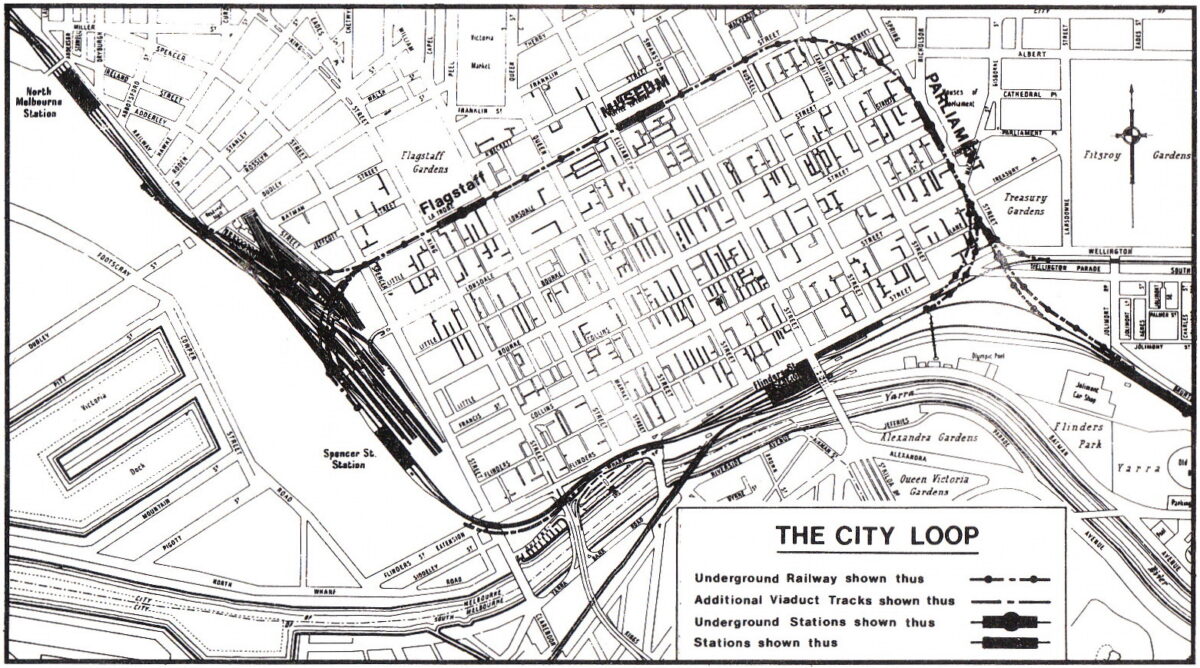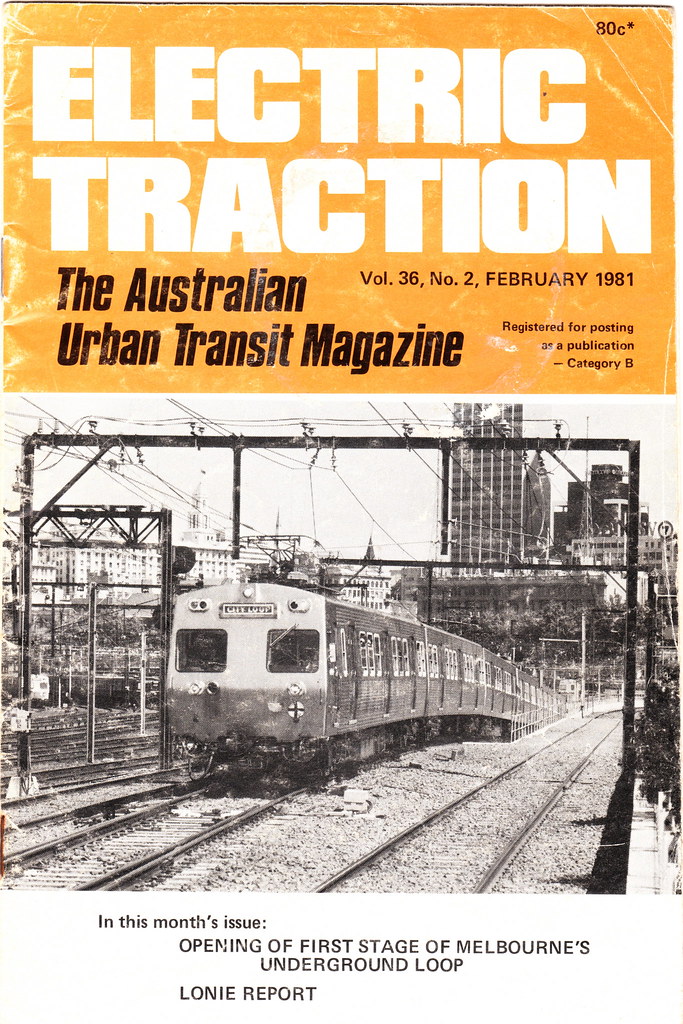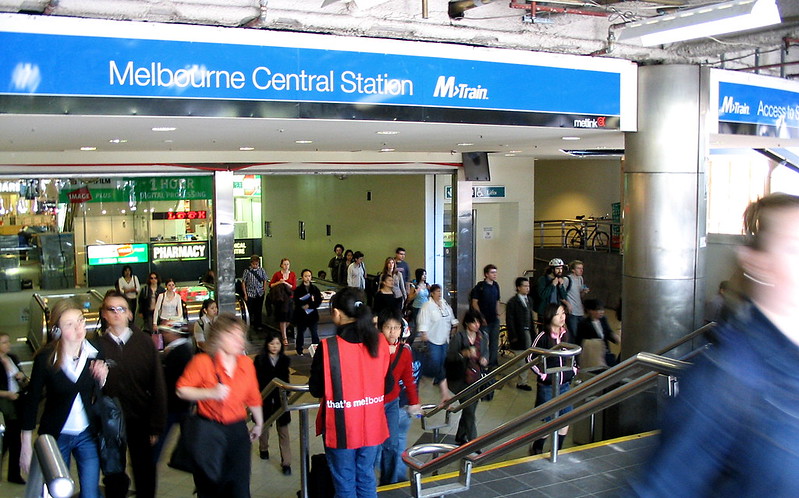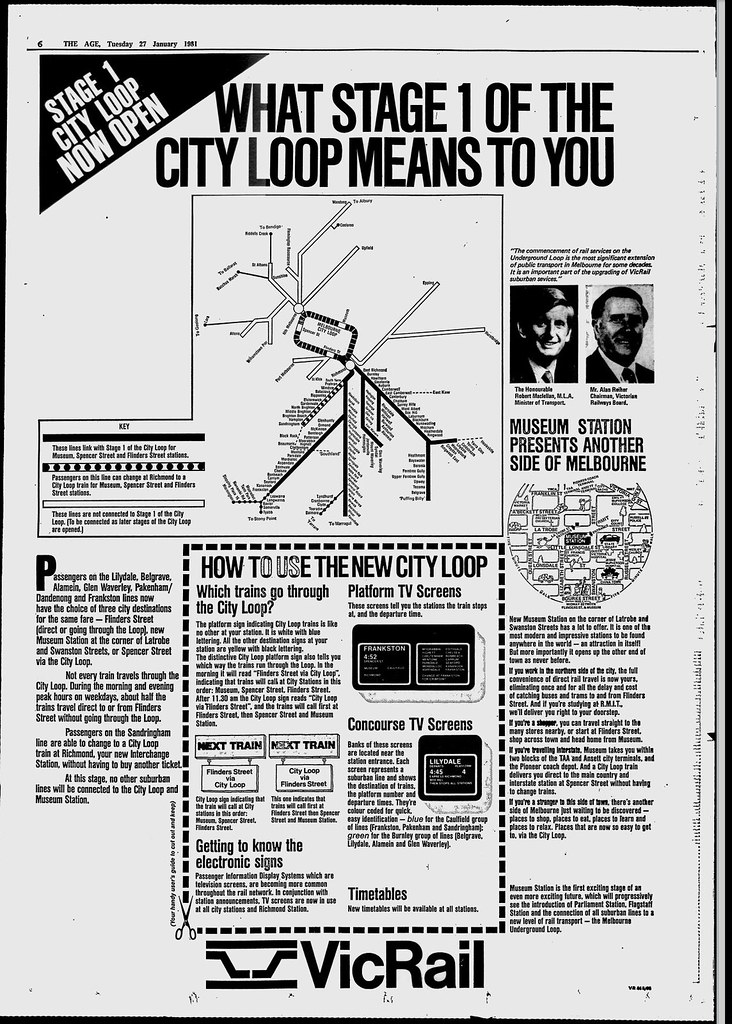Melbourne’s City Loop is four rail tunnels under the CBD, with three stations (Flagstaff, Melbourne Central and Parliament), adding to the two major ground level stations (Flinders Street and Southern Cross). The Loop was designed to distribute train passengers around the city centre more efficiently.
The Loop first opened forty years ago.
It’s debatable whether the anniversary is today, or on Tuesday. There was an official ceremony and free rides on Saturday 24th January 1981. Revenue service began two days later – on Australia Day, Monday 26th January 1981.
One of the bits and bobs I have from back then is the February 1981 edition of Electric Traction (journal of the Australian Electric Traction Association).
The magazine has some detail about the opening ceremony and the first days of operation.
Tait trains (the wooden “Red Rattlers” dating back to the 1910s) were officially banned from the City Loop. But the second revenue service (early on Monday 26/1/1981) was a Tait train. Whoops.
The first bypass of services out of the Loop was on Tuesday 27/1/1981 during the morning peak when a fire extinguisher system caused problems with gas fumes. Whoops again.
The Loop tunnels and stations were opened in stages between 1981 and 1985, so the initial service through the Loop was somewhat limited compared to today.
- 11/12/1978: Additional 2-track viaduct between Flinders Street and Spencer Street (now Southern Cross)
- 24/1/1981: Museum (now Melbourne Central) station; Burnley Loop; Caulfield Loop
- 6/12/1981: Clifton Hill Loop (City Circle only) – strange pic from the opening
- 31/10/1982: Clifton Hill Loop
- 22/1/1983: Parliament station
- 7/1/1985: Northern Loop
- 27/5/1985: Flagstaff station
Operations have varied over the years.
The Loop was initially only open Monday to Saturday (including most public holidays) until 1997 when Melbourne Central started opening regularly on Sundays, Parliament from 1999.
From 1997 Flagstaff closed on weekends – it re-opened on weekends in January 2016.
City Circle trains, mostly every 10-15 minutes, ran in the Clifton Hill loop tunnel from December 1981 until 1993. They were never as popular for getting around the CBD as the trams – which don’t involve first going down two levels underground. The trains were sort of replaced by the City Circle Tram in 1994.
The confusing weekday lunchtime change of direction was designed to facilitate trains being stored between the peaks in stabling, much of which doesn’t exist anymore.
Starting in 2008 the Clifton Hill Loop direction started to be made consistent, eventually running clockwise permanently. From next week’s timetable change, the Caulfield Loop will also run consistently anti-clockwise all the time.
Over time some lines have been switched to run direct, not via the Loop, to make space for more services, particularly at peak hour: Sandringham mostly in 1996, Werribee mostly in 2008, Frankston in 2021 – though in all those cases, they’ll only consistently run direct fulltime from next week.
When the Loop first opened, most off-peak (including Saturday) trains used it, but peak was a mix of direct and Loop trains on each line, with Transit Australia tallying up the services arriving at Flinders Street from 7am-9am, and departing from 4pm-6pm. This allows us to compare then vs now.
Burnley Loop: 1981 vs 2021
Below I’ve looked at the morning trains, and compared to the new 2021 timetable, to show how the patterns and total service provision compares.
| Line | Burnley group AM peak | 1981 direct | 1981 Loop | 2021 direct | 2021 Loop |
| Bel/Lily | from Blackburn | 3 | 1 | – | 4 |
| Bel/Lily | from Ringwood | 5 | 1 | – | 5 |
| Belgrave | from Upper Ferntree Gully | – | 2 | – | 2 |
| Belgrave | from Belgrave | 1 | 6 | – | 9 |
| Lilydale | from Mooroolbark | 1 | 1 | – | 3 |
| Lilydale | from Lilydale | 1 | 5 | – | 9 |
| Glen W | from Glen Waverley | 9 | 5 | 14 | – |
| Alamein | from Alamein | 8 | – | – | 6 |
| Total | 28 | 21 | 14 | 38 |
So there’s been a marginal increase in Burnley peak services: 49 trains total in 1981; 52 today, still with a myriad of starting locations on the Belgrave/Lilydale line. Two fewer Alamein services, but more from Lilydale instead.
The lack of growth is partly due to these lines not serving urban growth areas, though of course there’s been no shortage of infill development, and the CBD has boomed in the past few decades. At least train numbers have recovered from the cuts in 1993.
Burnley Loop operation today is much more consistent than in 1981: the Glen Waverley line runs direct to Flinders Street; other lines run via the Loop in the morning peak – though it’s switched around in the PM peak.
Caulfield Loop: 1981 vs 2021
| Line | Caulfield Loop AM peak | 1981 direct | 1981 via Loop | 2021 direct | 2021 via Loop |
| Frankston | from Cheltenham | 2 | 1 | ||
| Frankston | from Mordialloc | 2 | |||
| Frankston | from Aspendale | 1 | |||
| Frankston | from Carrum | 1 | 1 | 6 | |
| Frankston | from Seaford | 1 | |||
| Frankston | from Frankston | 7 | 3 | 16 | |
| Cran/Pak | from Oakleigh | 5 | – | ||
| Cran/Pak | from Dandenong | 5 | 3 | 3 | |
| Cran/Pak | from Pakenham | 4 | 3 | 12 | |
| Cran/Pak | from Westall | 1 | |||
| Cran/Pak | from Cranbourne | 9 | |||
| Total | 27 | 11 | 23 | 25 |
We are yet to see the full effects of the change, but it’s a lot easier to understand with all Frankston line trains running direct, and all Cranbourne/Pakenham trains running via the Loop anti-clockwise.
The numbers of trains on both lines has increased – a total of 38 in the morning peak of 1981, to 48 in 2021. (Frankston’s third track opened in 1987, which helped provide express trains for the first time.)
Forty years on
Forty years after it opened, it’s hard to imagine Melbourne’s CBD without the City Loop.
The way it’s used has gradually changed. Increasingly, specific lines use the Loop, and others run direct to maximise capacity.
It’ll be interesting to see if the Northern and Burnley Loop tunnels run in a consistent direction in the future.
The Metro tunnel, currently under construction, will add further to CBD rail capacity from 2025, taking the Sunbury and Cranbourne/Pakenham lines out of the Loop.
And hopefully in the near future the Metro 2 tunnel will get also funding, to cut journey times for the South Morang, Werribee, and potentially Geelong lines, as well as adding capacity to other lines.
Last week it was reported that public transport patronage was back to around 40% of the usual levels – but much of that is for non-suburban trips, as many office workers are still working from home.
As Melbourne gets back to normal (whatever the new normal becomes), people will be back on public transport, and our rail network, including the City Loop, will continue to show its worth.





8 replies on “40 years of the City Loop”
My dad worked for the VR for 35 years. He along with with his boss got to walk the loop prior to its opening. How in awe some of the older men were then… who knew a new tunnel now. My dad is 75 now. Thanks Daniel for great detail and bringing this up!! The memories for him!!
That “strange pic from the opening” looks so strange it looks like even the train is surprised by it :-)
(no offence).
I went for a free train ride when the Loop opened. I’m sure it was Australia Day as there was an veteran car exhibition in the Fitzroy Gardens. It was a very warm day and got on board a red rattler with its doors and windows open. The noise in the tunnel was deafening!
” it’s hard to imagine Melbourne’s CBD without the City Loop.”
Except if you are a Sandringham line commuter working/shopping near a loop station. From next week, it will be more efficient to walk to Flinders St station to catch your train rather than use a loop station. That’s taking us back 40 years!
@Roger – why? The ‘Burnley loop trains skipping Richmond’ speculation hasn’t eventuated, so can’t you just jump on one of them and interchange at Richmond?
My whole family went into the city the first weekend after it opened and rode trains around the loop several times. Melbourne’s first underground railway was such a novelty.
I’m all for consistent running, but the ability to cross-platform interchange at Burnley / Richmond for Burnley group services is too good to remove by making them run permanently clockwise. They just have to continue implementing what they started by having Glen Waverley trains run direct in the PM peak, as well as standardising stopping patterns / frequencies etc. If the Burnley group was made permanently clockwise then you have 4 direct to only 1 city loop platform in the AM peak at Richmond.
@Gobillino Yes, you are right. I was cheekily echoing Daniel’s advice to a St Vincent’s hospital worker from Sandringham – to walk to Flinders St station and avoid Parliament. When office workers get back to normal it will be an almighty bun fight at loop stations to get a Richmond train since commuters will only have half the trains available than previously.